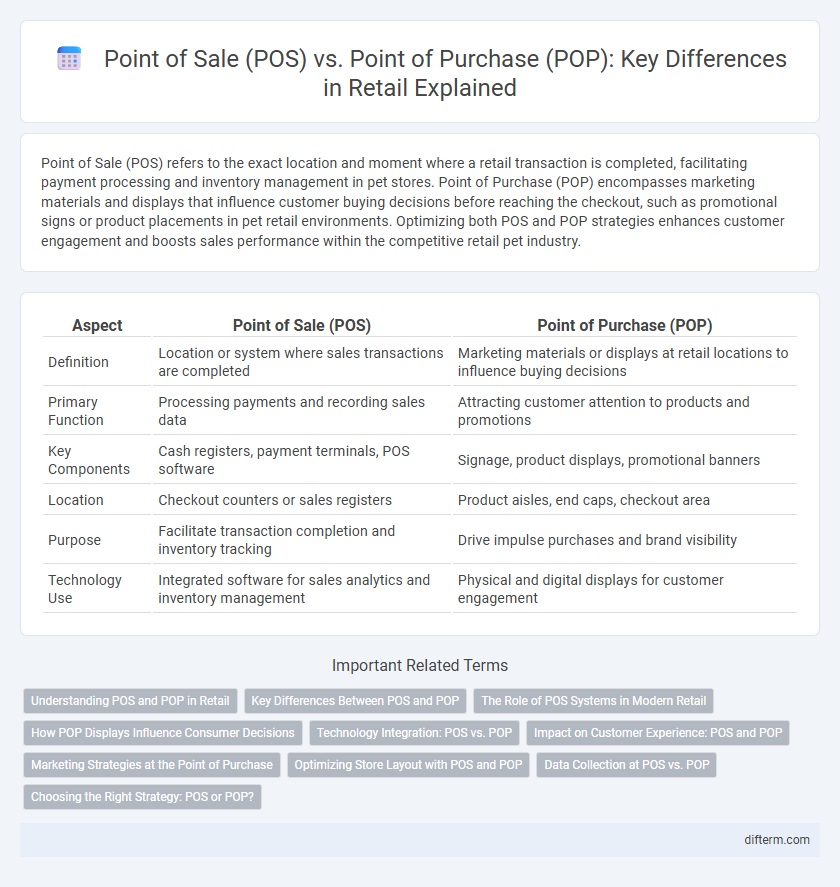Point of Sale (POS) refers to the exact location and moment where a retail transaction is completed, facilitating payment processing and inventory management in pet stores. Point of Purchase (POP) encompasses marketing materials and displays that influence customer buying decisions before reaching the checkout, such as promotional signs or product placements in pet retail environments. Optimizing both POS and POP strategies enhances customer engagement and boosts sales performance within the competitive retail pet industry.
Table of Comparison
| Aspect | Point of Sale (POS) | Point of Purchase (POP) |
|---|---|---|
| Definition | Location or system where sales transactions are completed | Marketing materials or displays at retail locations to influence buying decisions |
| Primary Function | Processing payments and recording sales data | Attracting customer attention to products and promotions |
| Key Components | Cash registers, payment terminals, POS software | Signage, product displays, promotional banners |
| Location | Checkout counters or sales registers | Product aisles, end caps, checkout area |
| Purpose | Facilitate transaction completion and inventory tracking | Drive impulse purchases and brand visibility |
| Technology Use | Integrated software for sales analytics and inventory management | Physical and digital displays for customer engagement |
Understanding POS and POP in Retail
Point of Sale (POS) refers to the exact location where a retail transaction occurs, involving hardware and software that facilitate payment processing and sales tracking. Point of Purchase (POP) encompasses marketing materials and displays positioned in-store to capture consumer attention and drive product sales. Understanding the distinction between POS technology and POP promotional strategies is crucial for optimizing retail operations and enhancing customer engagement.
Key Differences Between POS and POP
Point of Sale (POS) refers to the location and system where sales transactions are completed, including payment processing and receipt issuance. Point of Purchase (POP) encompasses marketing materials or displays designed to attract customers and influence buying decisions at the retail location. Key differences include POS being transaction-focused with hardware and software integration, while POP emphasizes promotional strategies and product visibility within store environments.
The Role of POS Systems in Modern Retail
POS systems streamline transaction processes by integrating payment processing, inventory management, and sales reporting, enhancing operational efficiency in modern retail environments. These systems enable real-time data collection, helping retailers analyze customer behavior and optimize stock levels. Effective POS technology supports personalized promotions and faster checkouts, improving overall customer experience and driving sales growth.
How POP Displays Influence Consumer Decisions
POP displays capture consumer attention at critical decision-making moments by showcasing products in visually compelling ways, directly increasing impulse purchases. Strategic placement and engaging designs of POP materials create an immediate connection between the shopper and the product, enhancing brand recall and driving sales. Retailers report that effective POP displays can boost product sales by up to 30%, proving their influence on consumer purchasing behavior.
Technology Integration: POS vs. POP
Point of Sale (POS) systems integrate advanced technology such as cloud-based software, mobile payment options, and real-time inventory management to streamline checkout processes and enhance customer experience. Point of Purchase (POP) technology primarily focuses on digital displays, interactive kiosks, and QR code integration aimed at influencing consumer buying decisions directly at the merchandising site. Retailers leveraging POS for transactional efficiency and POP for targeted in-store marketing gain a competitive edge by synchronizing sales data with personalized promotional content.
Impact on Customer Experience: POS and POP
Point of Sale (POS) and Point of Purchase (POP) play distinct but complementary roles in enhancing customer experience within retail environments. POS systems streamline transactions, reduce wait times through efficient payment processing, and enable personalized service by integrating customer data. POP displays strategically influence buying decisions by capturing attention with targeted promotions and product information, ultimately driving impulse purchases and reinforcing brand messaging at the critical moment of decision.
Marketing Strategies at the Point of Purchase
Marketing strategies at the Point of Purchase (POP) focus on influencing consumer decisions directly at the moment they are ready to buy, utilizing in-store displays, promotional signage, and product placement to maximize visibility and engagement. Unlike Point of Sale (POS) systems, which are primarily transactional tools handling checkout processes and payment, POP marketing aims to enhance impulse buying and brand recall by leveraging sensory appeal and strategic positioning within the retail environment. Effective POP strategies increase conversion rates and average transaction values by seamlessly integrating promotional messages with the shopper's purchasing journey.
Optimizing Store Layout with POS and POP
Optimizing store layout with Point of Sale (POS) and Point of Purchase (POP) strategies enhances customer flow and increases sales conversion rates. Integrating POS data analytics with POP displays helps retailers identify high-performing product locations and tailor in-store promotions effectively. Leveraging this synergy maximizes shelf space utilization and drives impulse purchases through targeted, data-driven merchandising.
Data Collection at POS vs. POP
Point of Sale (POS) systems capture transactional data such as product sales, payment methods, and customer purchase history directly at checkout, enabling precise sales analytics and inventory management. In contrast, Point of Purchase (POP) data centers around consumer interactions with marketing displays and promotional materials, gathering insights on engagement, product interest, and purchase intent prior to the transaction. Leveraging both POS and POP data provides retailers with a comprehensive view of customer behavior from initial interest to final sale, enhancing targeted marketing strategies and optimizing merchandising decisions.
Choosing the Right Strategy: POS or POP?
Choosing the right strategy between Point of Sale (POS) and Point of Purchase (POP) hinges on retail goals; POS systems streamline transaction processing and inventory management, enhancing operational efficiency and customer experience. POP marketing focuses on maximizing product visibility and influencing impulse buys at the retail location through displays, signage, and merchandising tactics. Retailers aiming to boost sales conversion should evaluate customer behavior data and store layout to determine whether technology-driven POS solutions or strategic POP displays better align with their sales objectives.
Point of Sale (POS) vs Point of Purchase (POP) Infographic

 difterm.com
difterm.com